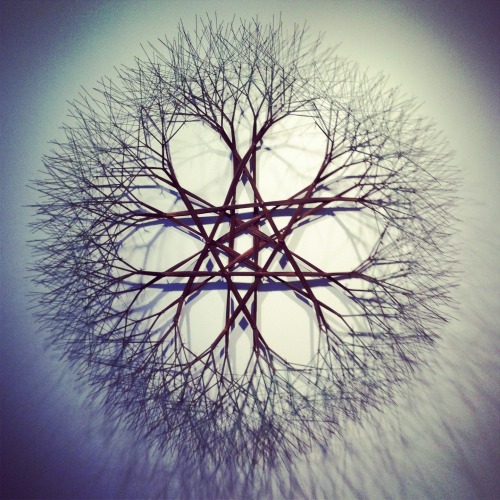
A wall sculpture by Ruth Asawa from her Christie's exhibition this spring. A reminder to be thorny.
As the year-end and best-of lists rain down, I have been thinking of my own highlight reel. For me it was a year of women. Maybe I was finally old enough to embrace the perspective that comes with my gender, or maybe it happened to be the year when a lot of other people started counting the number of women in architecture, in design, in technology, and in the media, on panels, in the history books, on editorial pages. I've always believed that you have to choose your own heroines. This year I made imaginary mentors out of a few new ones, as well as finally writing something personal about the woman that inspired me to be an architecture critic in the first place. Ten stories circling that theme.
Ada Louise, I miss you.
On Ada Louise Huxtable: a personal history, and a critic's assessment.
On Mariana Van Rensselaer, the mother of us all.
On the relation of craft to design, through fictional characters like Bernadette Fox, through the history of making in California, and through the better-than-fiction career of sculptor Ruth Asawa, memorialized by Robert Sullivan in this weekend's New York Times Magazine's "Lives They Lived" issue.
On the relation of children to design, and not replicating sexist patterns in the world of apps.
On the Pritzker Prize controvery, and how we can make the movement toward equality for women in architecture more than a 2013 meme. Is giving the first AIA Gold Medal to a women enough? No, and certainly not when she's been dead for 56 years.
Last but certainly not least, I am so saddened by the death of Bill Drenttel. Though I have often wished for hands-on mentors, for me Bill was a model of the hands-off type. I was thrilled when he asked me to join Design Observer as a contributing writer, and shocked when he said I could publish at will. No editing, no back-and-forth. As with the women critics of yore, Design Observer was a club that I had long wanted to be part of, and there he was, urging me to use my judgement about what to write and how to write it. As a result, we only met or spoke perhaps a dozen times, now a significant regret. Reading the tributes by those who knew him better, I see this brief, laser focus on what I could do (and do for the blog) was how he was able to accomplish so much. Trust is a gift, and I wished I had thanked him for it sooner.


Comments [5]
I would have liked to hear what Ada Louise thought about this trendy topic du jour of design media hacks, but everyone knows its rubbish. It's a man's world and it always will be. A few female PR media editors won't change that.
12.31.13
06:14
12.31.13
06:31
01.01.14
12:17
But i can't wait for the Design Observer article "Men are from Mars and Women are from Venus and Black People are So Good at Some Things!"
What is scary is that this is just a facade of improvement, a topic of conversation for people who don't really know or care about design itself. What is the first rule of advertising? Sex sells.
It's my personal opinion that both men and women could contribute to solving problems if we were not constantly distracted by these polarizing games that the media plays over and over to get attention. Ironically many of the best female figures come from the supposedly sexist era of the 40s, 50s and 60s. Why is that exactly?
01.02.14
11:50
I think one important part of being a good design critic is to not walk the same paths others have walked. To look where others haven't looked and be curious. And womens role in design have in a lot of ways been largely overlooked until now.
I feel sorry for Danny B. It's not a trendy topic, it's the future, and it's kind of sad that he's so uninterested in looking at history and design in a more open minded and curious way. There's a lot of interesting creative people and works of design to find out there and only things to gain by this new perspective.
Thank you Alexandra for pointing out a few interesting women I hadn't heard of previously.
04.03.14
06:41